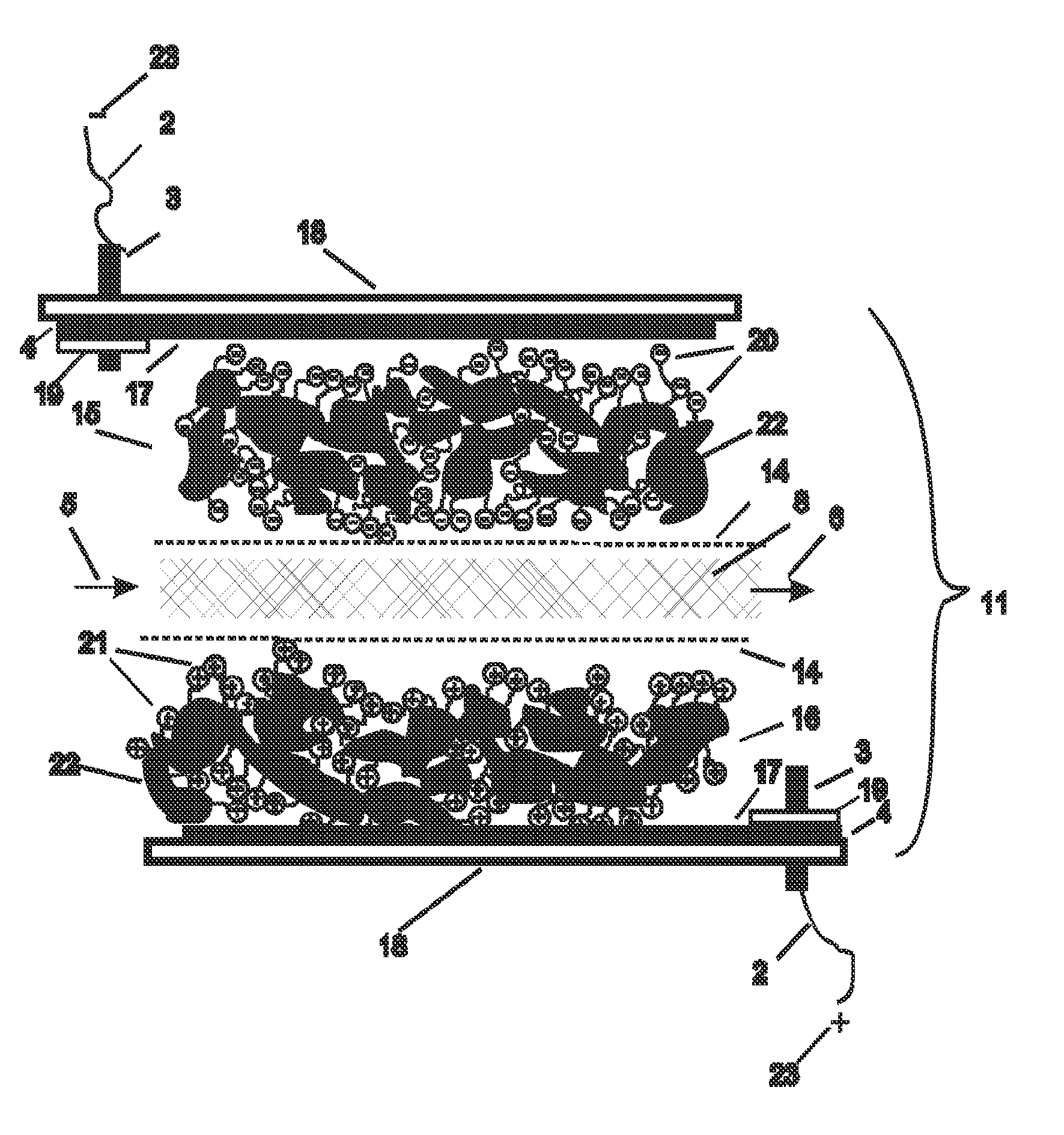Polarized Electrode for Flow-through Capacitive Deionization
a capacitive deionization and capacitor technology, applied in fluid pressure measurement, liquid/fluent solid measurement, peptide measurement, etc., can solve the problems of feed stream and lower coulombic efficiency, and achieve better purification, water, and energy efficiency. , the effect of improving coulombic efficiency
- Summary
- Abstract
- Description
- Claims
- Application Information
AI Technical Summary
Benefits of technology
Problems solved by technology
Method used
Image
Examples
example 1
[0126]In this example, the electrodes used were a high capacitance activated carbon powder electrode held together with 5% fibrillated PTFE binder made according to standard techniques similar to those described in many patents, including but not limited to U.S. Pat. No. 4,379,772, herein incorporated by reference. These electrodes were further modified into cation and anion responsive electrodes by soaking the electrodes in separate surfactant solutions at room temperature. For this experiment, sodium dodecyl sulfate, CAS number 151-21-3 was chosen as an anionic surfactant with which to adsorb and attach anionic groups on the cation responsive electrode, and hexadecyltrimethylammonium bromide, CAS number 57-09-0, (also known Cetrimonium bromide, ((C16H33)N(CH3)3Br, or cetyltrimethylammonium bromide) was chosen as the cationic surfactant with which to adsorb and attach cationic group on the anion responsive electrode. In order to form cation responsive electrodes the carbon electrod...
example 2
[0128]In another example, a mixture of 10% carbon black, and 90% activated carbon, jet milled to less than 40 microns, with a surface area of 1400 square meters per gram B.E.T (Brunauer, Emmett, Teller method), a total pore volume of 0.7 cubic centimeters per gram, and a combined meso and micropore volume of 0.4 cubic centimeters per gram, was used as a base capacitance material. Two batches of a one fourth subcritical micelle concentration of sodium dioctyl sulfosuccinate anionic surfactant and N-alkyl-N-2-hydroxyethyl-N,N-dimethyl ammonium bromide cationic surfactants respectively were added in separate containers in an excess amount of more than one half liter per 100 grams of electrode material respectively. The critical micelle concentration of surfactants was determined by isothermal titration calorimetry as described in “What can isothermal titration microcalorimetry experiments tell us about the self-organization of surfactants into micelles?” Kawthar Bouchemal et. al., J. M...
example 3
[0129]In another example, the procedure of example two was repeated with the addition of a 2% weight amount per dry weight electrode of the calcium ionophore ETH 5234 to the carbon electrode material batch containing the anionic surfactant. The cation responsive electrode resulting from adsorption of this ionomer to the carbon electrode surface was used together with the anion responsive electrode of example 2 in a flow through capacitor that selectively removed calcium and- or alkalinity from feed water for use in water softening applications.
PUM
| Property | Measurement | Unit |
|---|---|---|
| Fraction | aaaaa | aaaaa |
| Fraction | aaaaa | aaaaa |
| Thickness | aaaaa | aaaaa |
Abstract
Description
Claims
Application Information
 Login to View More
Login to View More - R&D
- Intellectual Property
- Life Sciences
- Materials
- Tech Scout
- Unparalleled Data Quality
- Higher Quality Content
- 60% Fewer Hallucinations
Browse by: Latest US Patents, China's latest patents, Technical Efficacy Thesaurus, Application Domain, Technology Topic, Popular Technical Reports.
© 2025 PatSnap. All rights reserved.Legal|Privacy policy|Modern Slavery Act Transparency Statement|Sitemap|About US| Contact US: help@patsnap.com



